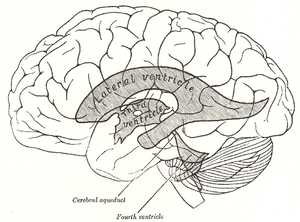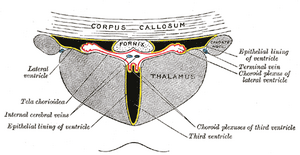No edit summary |
No edit summary |
||
| Line 8: | Line 8: | ||
Each lateral ventricle has three horns. The anterior or frontal horn extends into the [[frontal lobe]], the posterior or occipital horn into the [[occipital lobe]], and the inferior or temporal horn into the [[temporal lobe]]. |
Each lateral ventricle has three horns. The anterior or frontal horn extends into the [[frontal lobe]], the posterior or occipital horn into the [[occipital lobe]], and the inferior or temporal horn into the [[temporal lobe]]. |
||
| + | |||
| + | |||
| + | ==See also== |
||
| + | *[[Angular bundle]] |
||
==External links== |
==External links== |
||
Latest revision as of 22:43, 1 April 2010
Assessment |
Biopsychology |
Comparative |
Cognitive |
Developmental |
Language |
Individual differences |
Personality |
Philosophy |
Social |
Methods |
Statistics |
Clinical |
Educational |
Industrial |
Professional items |
World psychology |
Biological: Behavioural genetics · Evolutionary psychology · Neuroanatomy · Neurochemistry · Neuroendocrinology · Neuroscience · Psychoneuroimmunology · Physiological Psychology · Psychopharmacology (Index, Outline)

Gray's FIG. 734– Scheme showing relations of the ventricles to the surface of the brain.

Gray's FIG. 723– Coronal section of lateral and third ventricles.
The lateral ventricles are part of the ventricular system of the brain. Classified as part of the telencephalon, they are the largest of the ventricles. The lateral ventricles connect to the central third ventricle through the interventricular foramina of Monro.
Each lateral ventricle has three horns. The anterior or frontal horn extends into the frontal lobe, the posterior or occipital horn into the occipital lobe, and the inferior or temporal horn into the temporal lobe.
See also
External links
- BrainInfo at the University of Washington hier-191
- MeSH Lateral+Ventricles
- Dissection
- Illustration of horns
| This page uses Creative Commons Licensed content from Wikipedia (view authors). |